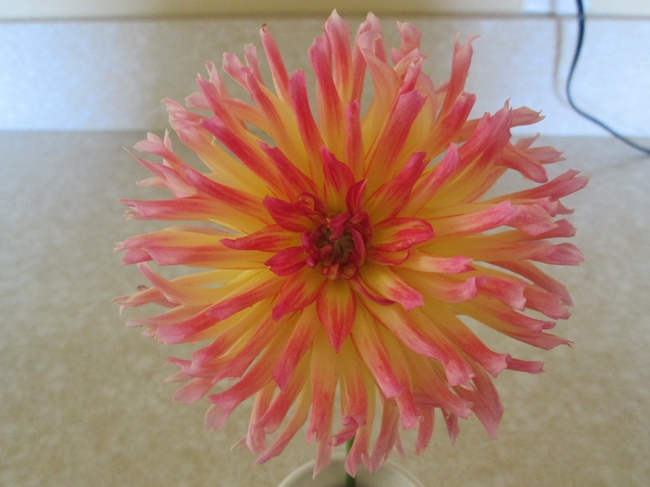The hour of the Dahlia
August and September are when dahlia plants are at peak performance. It is also when heat encourages spider mites to attack. The damage looks as though the plants are drying out at the bottom. If you look under the infected leaves, they will feel sticky and you will find black specks.
The best practice for controlling mites is removing the infected leaves at the bottom of the plant and washing the plants with a strong spray of the hose. Using an insecticide can make the problem worse by killing the beneficial insects that feed on the mites. If you catch it in time the plant will continue to produce beautiful flowers for you, they just won't have any leaves on the lower part of the plant.
Preserving Dahlia Blooms

Bring them in the house and set them in 2-3 inches of very hot water. Use either a plastic or metal container that doesn't retain heat. I use an automatic hot water pot and get the water to boiling before filling the plastic/metal container.
Leave the blooms in this water until it has cooled and then transfer them to your vase. You can cut the discolored ends of the stems off or leave them on, it doesn't matter. This method of preserving blooms works on any woody stemmed flower.
I recommend that you change your vase water daily. You may also use a homemade flower preservative of 2 tablespoons sugar and 2 tablespoons vinegar along with a 1/4 teaspoon of bleach to a gallon of water.
Digging
Dig up your dahlia tuber about two weeks after a killing frost or November 15th, whichever comes first. Do not dig too early. Cut the stalks down to 6”. Gently lift with a spade being careful not to break the tuber necks. Wash off the tubers and let them dry, protected from the elements, for 24 hours. Ensure that they don't dry too much - our climate dries quickly.
If you have an area in your yard that will protect your tubers from winter frost you may try leaving your tubers in the ground over the winter. An area that is up against a southwest facing structure which will hold heat from the winter sun would be such a spot. For healthier, more productive plants be prepared to dig, divide and give these a winter rest every 2-3 years. You will have to experiment with this.
Storage
I'm still experimenting with this, so here is what the experts at Swan Island Dahlias say:
Use a storage medium such as slightly dampened peat moss, sand, or pet bedding material (sawdust/shavings). Tubers should be stored in crates or cardboard boxes line your boxes with 10 - 12 sheets of newspaper. Start your packing medium in the bottom and alternate layers of tubers and medium until the container is full. Never store your tubers in plastic or completely sealed containers. Store them in a cool, dry area. Ideal temperature of the storage location is 40-50 degrees. If the tubers are kept too warm they will wrinkle and shrivel, too cold they will freeze and rot. Check on your tubers thought the winter months.